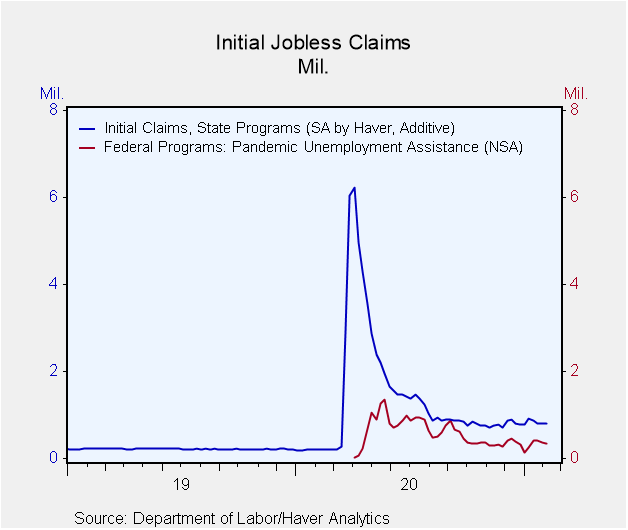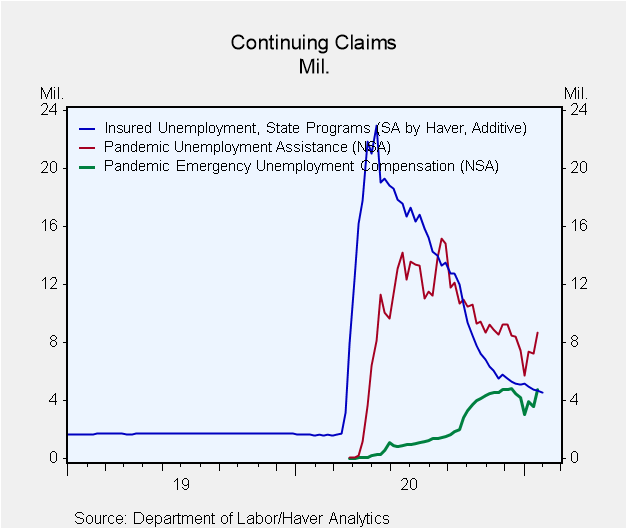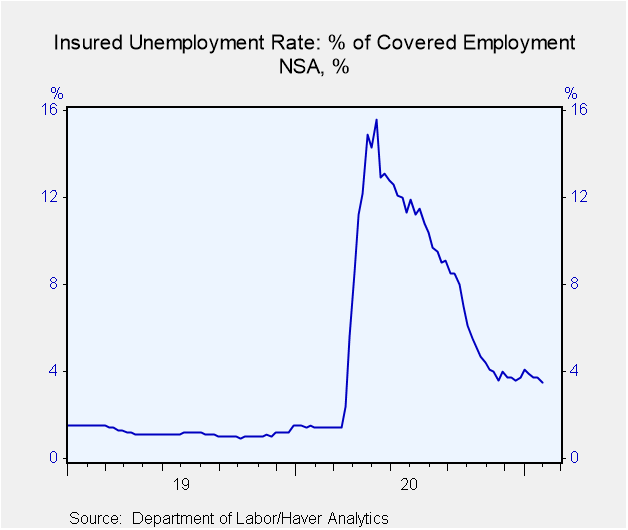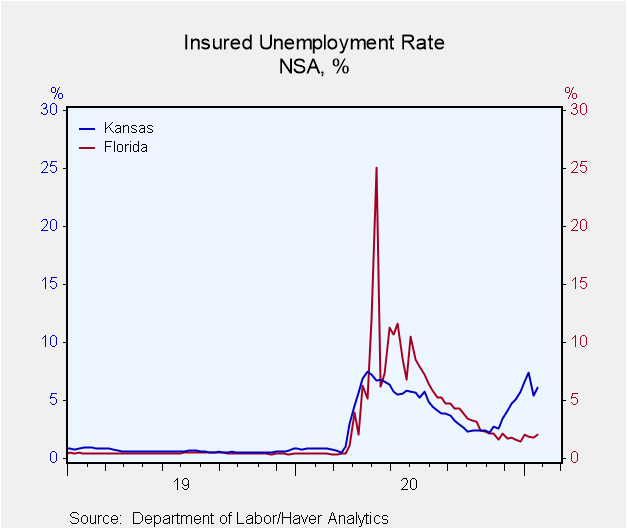 Global| Feb 11 2021
Global| Feb 11 2021U.S. Initial Jobless Insurance Claims and Continuing Claims Decline
by:Tom Moeller
|in:Economy in Brief
Summary
• State initial claims fall to the lowest level in five weeks. • Continuing claims also decrease to a four-week low. • Insured jobless rate eases to lowest level since late-March. Initial claims for unemployment insurance declined to [...]
• State initial claims fall to the lowest level in five weeks.
• Continuing claims also decrease to a four-week low.
• Insured jobless rate eases to lowest level since late-March.
Initial claims for unemployment insurance declined to 793,000 during the week ended February 6 from 812,000 during the prior week, revised from 779,000. The four-week moving average of initial claims fell to 823,000, a five-week low. The latest week compared to 757,000 claims expected in the Action Economics Forecast Survey.
Initial claims for the federal Pandemic Unemployment Assistance (PUA) program amounted to 334,524. This compares to a recent high of 455,037 in the second week of December. The PUA program covers individuals such as the self-employed who are not included in regular state unemployment insurance. Given the brief history of this program, which started April 4, 2020, these and other COVID-related series are not seasonally adjusted.
Continuing claims for regular state unemployment insurance fell to 4.545 million in the week ended January 30 from 4.690 million in the prior week, revised from 4.592 million. Continuing PUA claims, which are lagged an additional week and are not seasonally adjusted, rose to 8.715 million from 7.219 million in the prior week. The Pandemic Emergency Unemployment Compensation (PEUC) claims jumped to 4.778 million in the January 23 week from 3.605 in the prior week. This program covers people who were unemployed before COVID but exhausted their state benefits and are now eligible to receive benefits through March 14, 2021.
The total number of all state, federal and PUA and PEUC continuing claims surged to 20.435 million after falling sharply to 17.839 million in the prior week. This grand total also is not seasonally adjusted.
The seasonally adjusted state insured rate of unemployment decreased to 3.2% in the week ended January 30, from an upwardly revised 3.3% in the prior week.
The state insured rates of unemployment – which do not include the special federal programs – continued to show wide variation. In the week ended January 23, Alabama had the lowest rate at 0.88%. Pennsylvania had the highest rate at 6.84%. The rate in Kansas, which had been the highest, fell back to 6.08%. Among the larger states, Florida had a rate of 2.04%, Texas stood at 2.80%. California was 4.60%, New York was 5.08% and Illinois' rate was 5.47%. These state rates are not seasonally adjusted.
As we continue to point out, the Labor Department changed its seasonal adjustment methodology back in August from multiplicative to additive. They did not restate the earlier data, so there is a break in the series in late August. Though the current comparison to early September is valid, comparisons with figures before August 22 are not. Haver Analytics has calculated methodologically consistent seasonally adjusted claims series dating back to 1979. This series matches the Department of Labor seasonally adjusted series since their change in methodology. For more details, please see the September 3 commentary on jobless claims.
Data on weekly unemployment claims going back to 1967 are contained in Haver's WEEKLY database, and they are summarized monthly in USECON. Data for individual states are in REGIONW. The expectations figure is from the Action Economics Forecast Survey, carried in the AS1REPNA database.
Getting Back to a Strong Labor Market from Fed Chair Jerome H. Powell can be found here.| Unemployment Insurance (SA, 000s) | 02/06/21 | 01/30/21 | 01/23/21 | Y/Y % | 2020 | 2019 | 2018 |
|---|---|---|---|---|---|---|---|
| Initial Claims | 793 | 812 | 812 | 289 | 1,450 | 218 | 221 |
| Initial Claims (NSA) | 813 | 850 | 840 | 270 | 1,367 | 218 | 221 |
| Initial Claims Pandemic Unemployment Assistance (NSA) | 335 | 369 | 404 | -- | -- | -- | -- |
| Continuing Claims | -- | 4,545 | 4,690 | 171 | 10,664 | 1,701 | 1,756 |
| Continuing Claims (NSA) | -- | 5,025 | 5,193 | 141 | 10,358 | 1,704 | 1,763 |
| Continuing Claims Pandemic Unemployment Assistance (NSA) | -- | -- | 8,715 | -- | -- | -- | -- |
| Insured Unemployment Rate (%) | -- | 3.2 | 3.3 |
1.2 |
7.3 | 1.2 | 1.2 |
Tom Moeller
AuthorMore in Author Profile »Prior to joining Haver Analytics in 2000, Mr. Moeller worked as the Economist at Chancellor Capital Management from 1985 to 1999. There, he developed comprehensive economic forecasts and interpreted economic data for equity and fixed income portfolio managers. Also at Chancellor, Mr. Moeller worked as an equity analyst and was responsible for researching and rating companies in the economically sensitive automobile and housing industries for investment in Chancellor’s equity portfolio. Prior to joining Chancellor, Mr. Moeller was an Economist at Citibank from 1979 to 1984. He also analyzed pricing behavior in the metals industry for the Council on Wage and Price Stability in Washington, D.C. In 1999, Mr. Moeller received the award for most accurate forecast from the Forecasters' Club of New York. From 1990 to 1992 he was President of the New York Association for Business Economists. Mr. Moeller earned an M.B.A. in Finance from Fordham University, where he graduated in 1987. He holds a Bachelor of Arts in Economics from George Washington University.










